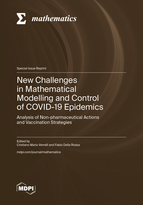New Challenges in Mathematical Modelling and Control of COVID-19 Epidemics: Analysis of Non-pharmaceutical Actions and Vaccination Strategies
A special issue of Mathematics (ISSN 2227-7390). This special issue belongs to the section "E3: Mathematical Biology".
Deadline for manuscript submissions: closed (30 September 2023) | Viewed by 30743
Special Issue Editors
Interests: control systems engineering; biosystems engineering; mechatronics control systems; adaptive control
Special Issues, Collections and Topics in MDPI journals
Special Issue Information
Dear Colleagues,
Since being officially reported in December 2019 in China, COVID-19 (SARS-CoV-2) immediately reached pandemic proportions throughout six continents and over 210 countries, with the effects on the different age strata of society being highly nonuniform.
Long-term lockdowns were unfeasible and contact-tracing procedures dramatically lost their efficacy at high case numbers. Afterward, the availability of approved COVID-19 vaccines, such as Pfizer/BioNTech, Moderna, Oxford–AstraZeneca AZD1222, and J&J Ad26.COV2.S, has led to mass vaccination rollouts around the world. However, several concerns are being raised given the recent emergence of new COVID-19 variants, which are reported to have increased transmissibility and possibly cause more severe disease compared to the original strain. The potential of such variants for vaccine-induced immunity escape, along with the slightly uncertain duration of vaccine-based immunity, has led to the expectation that vaccination alone will not control the spread of the infection. It is now becoming clear that a carefully planned vaccination campaign (possibly including children as new actors worldwide) needs to be coordinated with continued implementation of nonpharmaceutical interventions, including the alternation of opening and closure phases and public health policy actions to preserve social distancing.
With vaccine efficacy, variants’ actions, age-stratification effects, and the specificity of individual behaviours as potential game-changers, researchers are encouraged to implement new strategies while combining innovative approaches for interpreting current epidemic scenarios and forecasting new ones.
Accordingly, the goal of this Special Issue is to present new results and tools in mathematical modelling (both in the stochastic and the deterministic frames) for the control of epidemics to identify the complex dynamics at the root of this situation.
Relying on the multidisciplinary approach that is typical of complex systems, research papers, communications, and review articles from different mathematical and engineering fields are welcome on the following subtopics:
- Analysis of the effects of vaccination strategies by considering the specificity of vaccines and the related immunity duration, age-dependent factors, mechanisms of virus transmission, the specificity of individual behaviours, spatial effects, social networks, and contact patterns.
- Analysis of the effects of COVID-19 variants in terms of increased transmissibility and severity of disease, as well as of vaccine-induced immunity escape.
- Analysis of the effects of nonpharmaceutical interventions and their relative weight with respect to vaccination strategies in terms of deaths and infections.
- Analysis of coordinated actions, including non-pharmaceutical interventions and vaccination
strategies.
Prof. Dr. Cristiano Maria Verrelli
Prof. Dr. Fabio Della Rossa
Guest Editors
Manuscript Submission Information
Manuscripts should be submitted online at www.mdpi.com by registering and logging in to this website. Once you are registered, click here to go to the submission form. Manuscripts can be submitted until the deadline. All submissions that pass pre-check are peer-reviewed. Accepted papers will be published continuously in the journal (as soon as accepted) and will be listed together on the special issue website. Research articles, review articles as well as short communications are invited. For planned papers, a title and short abstract (about 100 words) can be sent to the Editorial Office for announcement on this website.
Submitted manuscripts should not have been published previously, nor be under consideration for publication elsewhere (except conference proceedings papers). All manuscripts are thoroughly refereed through a single-blind peer-review process. A guide for authors and other relevant information for submission of manuscripts is available on the Instructions for Authors page. Mathematics is an international peer-reviewed open access semimonthly journal published by MDPI.
Please visit the Instructions for Authors page before submitting a manuscript. The Article Processing Charge (APC) for publication in this open access journal is 2600 CHF (Swiss Francs). Submitted papers should be well formatted and use good English. Authors may use MDPI's English editing service prior to publication or during author revisions.
Keywords
- COVID-19
- SARS-CoV-2
- modelling
- control
- vaccine
- virus transmission
- spatial effects
- contact patterns
- variants
- immunity
- social distancing
- nonpharmaceutical actions
- age strata
- complex dynamics
Benefits of Publishing in a Special Issue
- Ease of navigation: Grouping papers by topic helps scholars navigate broad scope journals more efficiently.
- Greater discoverability: Special Issues support the reach and impact of scientific research. Articles in Special Issues are more discoverable and cited more frequently.
- Expansion of research network: Special Issues facilitate connections among authors, fostering scientific collaborations.
- External promotion: Articles in Special Issues are often promoted through the journal's social media, increasing their visibility.
- e-Book format: Special Issues with more than 10 articles can be published as dedicated e-books, ensuring wide and rapid dissemination.
Further information on MDPI's Special Issue policies can be found here.







